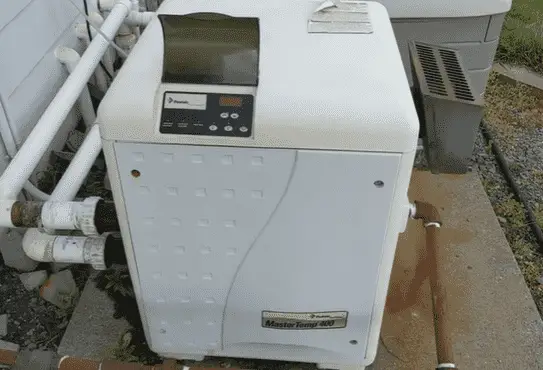When Pentair MasterTemp 400 ignition lockout occurs, your heater will display the error code ERR IGN.
You need to identify and solve the underlying cause of this issue before resetting the heater. The device should be out of ignition lockout at that point.
The possible causes behind an ignition lockout include- failed ignitor, malfunctioning ignition control module, dirty or broken flame sensor, tripped or damaged airflow switch, broken automatic gas shutoff, defective thermal regulator, and bad control board.
Table Of Contents
- Pentair MasterTemp 400 Ignition Lockout [7 Easy Fixes]
- 1. Failed Ignitor
- Solution:
- 2. Malfunctioning Ignition Control Module
- 3. Dirty or Broken Flame Sensor
- 4. Tripped or Damaged Air Flow Switch
- 5. Broken Automatic Gas Shutoff Switch
- 6. Defective Thermal Regulator
- 7. Bad Control Board
- FAQs:
- How much does an ignition control module cost?
- How do you test an ignition control module?
- What does err PS mean on Pentair heater?
- What does a high-limit switch do on a pool heater?
- What does the E05 error mean?
- Conclusion
Pentair MasterTemp 400 Ignition Lockout [7 Easy Fixes]
In this section, we will explore the causes behind ignition lockout in more depth as well as for instructions on what to do during an ignition lockout on a pool heater.
Note: You can also read how to fix Pentair MasterTemp 400 common problems.
1. Failed Ignitor
Another typical cause of a Pentair heater ignition lockout is a faulty igniter. Your heater will not light if the igniter fails to create a spark.
Solution:
The igniter can be found close to the top of the combustion chamber. Follow the actions outlined below to replace it.
Step 1: Shut down the pump as well as all power to the heater. The ignitor is connected to the Molex connector with wires. Remove the wiring connection.
Step 2: Remove the nuts that secure the Igniter Bracket. Carefully detach the HSI from the unit.
Step 3: To test, look for resistance across the HSI scale. The reading should be 50-500 Ohm at room temperature. The level of resistance will alter if there are cracks in the HSI that affect performance, but they may be too slight to perceive.
Step 4: Replace the HSI by reversing steps 1 through 4. You must also restore the Igniter Gasket when repairing the HSI.
Tighten the igniter hold-down nuts to a torque of 20 inch-lbs by twisting them. It’s possible that overtightening the HSI base will cause it to break.
Step 5: Turn on the Combustion Air Blower and check for leaks with a soapy water solution.
2. Malfunctioning Ignition Control Module
Pentair MasterTemp 400 ignition control module, sometimes known as the ICM, is in charge of the ignition sequence and timing.
The ignition system comes apart when the module fails. Your heater light may be blinking because of a failed ICM.
Solution:
This problem can only be solved by replacing the ICM. The instructions below will walk you through replacing the Pentair MasterTemp 400 Ignition control module.
Step 1: Take off the left side panel of the heater.
Step 2: Disconnect the system from the Max-E-Therm heater. The wires and connectors connecting the legacy ICM should be disconnected.
Step 3: Disconnect the heater’s previous ICM unit.
Step 4: Insert the new ICM into the Junction Box chamber of the heater. When replacing the ICM, connect the wires according to the installation manual.
Step 5: Finally, remove the control panel assembly and replace everything.
3. Dirty or Broken Flame Sensor
Check for corrosion on the Pentair MasterTemp 400 flame sensor. Look for any evidence of cracking on the flame sensor porcelain. This could be a sign of a faulty flame sensor.
Solution:
Bypass the flame sensor to determine if the pool warmer will fire without it. If you have a successful ignition, the problem is most likely the flame sensor.
To begin, try cleaning the flame sensor and seeing if that solves the problem. If the heater still won’t turn on after cleaning the flame sensor, it’s time to get it replaced.
4. Tripped or Damaged Air Flow Switch
The airflow switch is factory set and attached to the ignition module. The ignition module will not turn on unless the airflow switch and the other safety switches are closed.
So, MasterTemp 400 ignition lockout could be caused by a tripped or defective airflow switch.
Solution:
Make sure the blower is running properly and nothing is impeding the airflow to reset the AFS. If the blower is working properly, you may have a faulty air flow switch. It should be replaced.
5. Broken Automatic Gas Shutoff Switch
The automatic gas shutoff or AGS switch is another safety feature of your Pentair heater. A defective AGS switch can cause ignition failure.
Solution:
You need to follow the instructions given below to replace the AGS switch.
Step 1: Turn off the filter pump as well as the heater’s electrical power. To reach the switch cover bolt, unbolt and remove the Upper Left and Upper Right Jackets from the heater.
Step 2: If the heater is below the pool’s water level, close the isolation valves to prevent the pool from draining.
Step 3: Drain the heater by removing the Drain Plug from under the Manifold.
Step 4: Take the switch cover off. Unplug the AGS wires from the Switch. Remove the AGS Switch from the Manifold by unscrewing it.
Step 5: Take the new AGS switch and reverse steps 1 through 4 to replace it.
6. Defective Thermal Regulator
The Thermal Regulator is a regulated valve that regulates water flow in order to maintain a temperature over 120 degrees Fahrenheit at the Heat Exchanger Outlet. A defective thermistor can cause an ignition lockout.
Solution:
You can test the thermal regulator’s continuity by removing it. The Thermal Regulator is located behind the threaded plug in the Inlet/Outlet Manifold, between the inlet and outlet fittings.
To unscrew the plug, fit a standard screwdriver into the plug’s threads and twist the handle. Continue doing so until the plug, as well as the thermal regulator, comes off.
Fill a jar halfway with 130°F water. To see if the thermal regulator opens, submerge it in water. You have a working thermal regulator if it opens.
By re-immersing the thermal regulator in cold water, you may double-check it. If the gadget is in good working order, it should close again. Replace the thermistor if the test points towards a defect.
7. Bad Control Board
The control board is in charge of almost all of the activities of your pool heater. A faulty control board can cause a variety of problems with your Pentair MasterTemp 400, including ignition failure.
Solution:
If your control board is broken, you must replace it. Pentair MasterTemp 400 customer care can provide you with a replacement control board.
FAQs:
How much does an ignition control module cost?
The typical cost of replacing an ignition control module is $292-$398. Labor costs are projected to be between $57 and $71 per hour, with parts costing between $235 and $327 per hour.
How do you test an ignition control module?
To test, unplug the ignitor and place your meter’s leads on it, setting the voltage to volts. Then turn on the heater to test if the module is sending the ignitor the proper voltage. If it isn’t, there’s a problem with the module.
What does err PS mean on Pentair heater?
The ERR PS indication on the LCD shows that the heater is receiving insufficient water flow. If the pump is running, it’s likely that the filter and/or skimmers need to be cleansed. Some filters need back-washing.
What does a high-limit switch do on a pool heater?
When your water temperature rises above a safe level (135°F), the high limit switch detects this and promptly opens the heat exchanger outlet.
What does the E05 error mean?
It means your stack flue sensor has tripped. When exhaust temperatures are above 350 degrees, this occurs. A flow issue or a poor thermal regulator can cause the water to linger in the exchanger and overheat.
Conclusion
Hopefully, you now know what to do during a Pentair MasterTemp 400 ignition lockout. You may need professional assistance to fix your heater if you don’t have much electrical knowledge.
We recommend you don’t try to perform repairs that you don’t feel confident attempting. It is always better to be safe than sorry.

